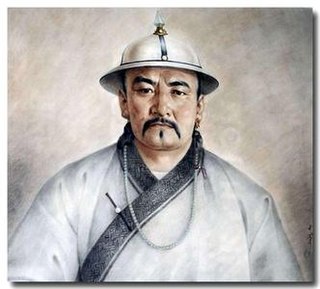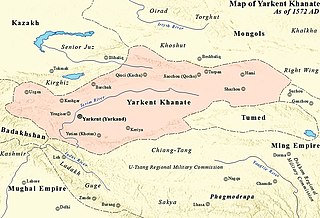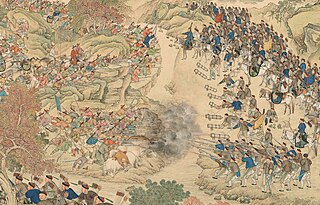| |||||
| Decades: | |||||
|---|---|---|---|---|---|
| See also: | Other events of 1679 History of China • Timeline • Years | ||||
Events from the year 1679 in China .
| |||||
| Decades: | |||||
|---|---|---|---|---|---|
| See also: | Other events of 1679 History of China • Timeline • Years | ||||
Events from the year 1679 in China .

The Qianlong Emperor was the fifth Emperor of the Qing dynasty, and the fourth Qing emperor to rule over China proper, reigned from 1735 to 1796. Born Hongli, the fourth son of the Yongzheng Emperor, he reigned officially from 11 October 1735 to 8 February 1796. In 1796, he abdicated in favour of his son, the Jiaqing Emperor—a filial act in order not to reign longer than his grandfather, the Kangxi Emperor, who ruled for 61 years. Despite his retirement, however, he retained ultimate power as the Retired Emperor until his death in 1799. He thus was one of the longest-reigning rulers in the history of the world, and dying at the age of 87, one of the longest-lived. As a capable and cultured ruler inheriting a thriving empire, during his long reign the Qing Empire reached its most splendid and prosperous era, boasting a large population and economy. As a military leader, he led military campaigns expanding the dynastic territory to the largest extent by conquering and sometimes destroying Central Asian kingdoms. This turned around in his late years: the Qing empire began to decline with corruption and wastefulness in his court and a stagnating civil society.

The Dzungar Khanate, also written as the Zunghar Khanate, was an Inner Asian khanate of Oirat Mongol origin. At its greatest extent, it covered an area from southern Siberia in the north to present-day Kyrgyzstan in the south, and from the Great Wall of China in the east to present-day Kazakhstan in the west. The core of the Dzungar Khanate is today part of northern Xinjiang, also called Dzungaria.

Choros Erdeniin Galdan was a Dzungar-Oirat Khan of the Dzungar Khanate. As fourth son of Erdeni Batur, founder of the Dzungar Khanate, Galdan was a descendant of Esen Taishi, the powerful Oirat Khan of the Northern Yuan dynasty who united the western Mongols in the 15th century. Galdan's mother Yum Aga was a daughter of Güshi Khan, the first Khoshut-Oirat King of Tibet.

Öndör Gegeen Zanabazar was the sixteenth Jebtsundamba Khutuktu and the first Bogd Gegeen or supreme spiritual authority, of the Gelugpa lineage of Tibetan Buddhism in Outer Mongolia.

Xinjiang historically consisted of two main geographically, historically, and ethnically distinct regions with different historical names: Dzungaria north of the Tianshan Mountains; and the Tarim Basin south of the Tianshan Mountains, currently mainly inhabited by the Uyghurs. They were renamed Xinjiang (新疆) in 1884, meaning "new frontier," when both regions were reconquered by the Chinese Qing dynasty after the Dungan revolt (1862–1877).

Mongolia under Qing rule was the rule of the Qing dynasty over the Mongolian steppe, including the Outer Mongolian 4 aimags and Inner Mongolian 6 leagues from the 17th century to the end of the dynasty. "Mongolia" here is understood in the broader historical sense. The last Mongol Khagan Ligden saw much of his power weakened in his quarrels with the Mongol tribes, was defeated by the Later Jin dynasty, and died soon afterwards. His son Ejei Khan gave Hong Taiji the imperial authority, ending the rule of Northern Yuan dynasty then centered in Inner Mongolia by 1635. However, the Khalkha Mongols in Outer Mongolia continued to rule until they were overrun by the Dzungar Khanate in 1690, and they submitted to the Qing dynasty in 1691.

The Northern Yuan was a dynastic regime ruled by the Mongol Borjigin clan based in the Mongolian Plateau. It operated as a rump state after the collapse of the Yuan dynasty of China in 1368 and lasted until its conquest by the Jurchen-led Later Jin dynasty in 1635. The Northern Yuan dynasty began with the end of Yuan rule in China proper and the retreat of the Yuan remnants led by Toghon Temür to the Mongolian steppe. This period featured factional struggles and the often only nominal role of the Great Khan.

There were several Mongol invasions of Tibet. The earliest is the alleged plot to invade Tibet by Genghis Khan in 1206, which is considered anachronistic; there is no evidence of Mongol-Tibetan encounters prior to the military campaign in 1240. The first confirmed campaign is the invasion of Tibet by the Mongol general Doorda Darkhan in 1240, a campaign of 30,000 troops that resulted in 500 casualties. The campaign was smaller than the full-scale invasions used by the Mongols against large empires. The purpose of this attack is unclear, and is still in debate among Tibetologists. Then in the late 1240s Mongolian prince Godan invited Sakya lama Sakya Pandita, who urged other leading Tibetan figures to submit to Mongol authority. This is generally considered to have marked the beginning of Mongol rule over Tibet, as well as the establishment of patron and priest relationship between Mongols and Tibetans. These relations were continued by Kublai Khan, who founded the Mongol Yuan dynasty and granted authority over whole Tibet to Drogon Chogyal Phagpa, nephew of Sakya Pandita. The Sakya-Mongol administrative system and Yuan administrative rule over the region lasted until the mid-14th century, when the Yuan dynasty began to crumble.

The Dzungar–Qing Wars were a decades-long series of conflicts that pitted the Dzungar Khanate against the Qing dynasty of China and their Mongolian vassals. Fighting took place over a wide swath of Inner Asia, from present-day central and eastern Mongolia to Tibet, Qinghai, and Xinjiang regions of present-day China. Qing victories ultimately led to the incorporation of Outer Mongolia, Tibet and Xinjiang into the Qing Empire that was to last until the fall of the dynasty in 1911–1912, and the genocide of much of the Dzungar population in conquered areas.

The Yarkent Khanate, also known as the Yarkand Khanate and the Kashghar Khanate, was a state ruled by the Mongol descendants of Chagatai Khan, the majority of whose subjects and conquered population was Turkic in Central Asia. It was founded by Sultan Said Khan in 1514 as a western offshoot of Moghulistan, itself an eastern offshoot of the Chagatai Khanate. It was eventually conquered by the Dzungar Khanate in 1705.

The Revolt of the Altishahr Khojas was an uprising against the Qing dynasty of China, which broke out in 1757 during the reign of the Qianlong Emperor. The rebels were led by Khwāja-i Jahān, leader of the White Mountain Sufis. Qing era documents refer to the event as the "Pacification of the Muslim regions". Hojijan and his brother, Burhān al-Dīn, both held the Muslim title Khoja.

The Ganden Phodrang or Ganden Podrang was the Tibetan government that was established by the 5th Dalai Lama with the help of the Güshi Khan of the Khoshut in 1642. Lhasa became the capital of Tibet in the beginning of this period, with all temporal power being conferred to the 5th Dalai Lama by Güshi Khan in Shigatse. After the expulsion of the Dzungars, Tibet was under administrative rule of the Qing dynasty between 1720 and 1912, but the Ganden Phodrang government lasted until the 1950s, when Tibet was incorporated into the People's Republic of China. Kashag became the governing council of the Ganden Phodrang regime during the early Qing rule.
Altishahr, also known as Kashgaria, is a historical name for the Tarim Basin region used in the 18th and 19th centuries. The term means 'Six Cities' in Turkic languages, referring to oasis towns along the rim of the Tarim, including Kashgar, in what is now southern Xinjiang Uyghur Autonomous Region of China.

The Dzungar genocide was the mass extermination of the Mongol Dzungar people, at the hands of the Qing dynasty. The Qianlong Emperor ordered the genocide due to the rebellion in 1755 by Dzungar leader Amursana against Qing rule, after the dynasty first conquered the Dzungar Khanate with Amursana's support. The genocide was perpetrated by Manchu generals of the Qing army sent to crush the Dzungars, supported by Uyghur allies and vassals due to the Uyghur revolt against Dzungar rule.

The Dzungar conquest of Altishahr resulted in the Tibetan Buddhist Dzungar Khanate in Dzungaria conquering and subjugating the Genghisid-ruled Chagatai Khanate in Altishahr. It put a final end to the independence of the Chagatai Khanate.

Tibet under Qing rule refers to the Qing dynasty's rule over Tibet from 1720 to 1912. Güshri Khan of Khoshut Khanate reunified Tibet in 1642 under the 5th Dalai Lama, which lasted until 1717. Dzungar Khanate then invaded Tibet in 1717, and the Dzungars were subsequently expelled by Qing in 1720. The Qing emperors appointed resident commissioners known as Ambans to Tibet, most of them are ethnic Manchus, who reported to the Lifan Yuan, a Qing government body that oversaw the empire's frontier. Tibet during the Qing era retained political autonomy under the Dalai Lamas.
Events from the year 1667 in China.
Events from the year 1677 in China.
Events from the year 1680 in China.
Events from the year 1690 in China.